|
|
|
|
These are Monsters and Fabulous Creatures from Legends and Mythology All original images in this gallery are Copyright (C) Aleister Lam 2002 |
|
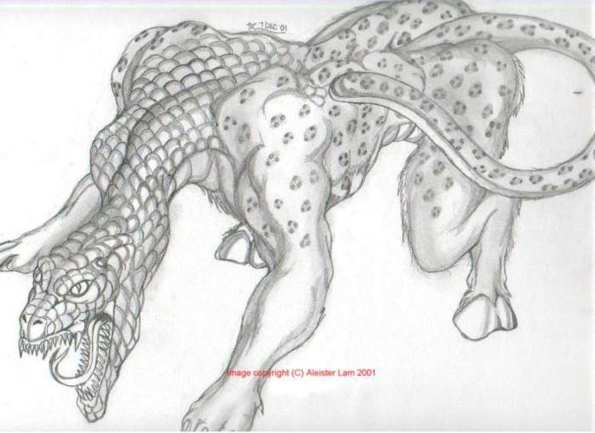 |
The Questing Beast The Questing Beast is first spotted in the Arthurian Legend, it is reputed to hav a romantic attachment to the knights that hunted it, like King Pellinore and Sir Palomides. Its appearance is described as that of a leopard with an anguine head, a forked tongue, leonine hindquarters and the hooves of a hart. Like Merlin, it too is the result of the union between a virgin & the demonic incubus. It is said that there's a princess that incestuously lusted for the affection of her brother due to his good look, boyish charm and charisma. One night, she summoned a incubus and made a pact with him to enable her to copulate with her brother. In actual fact, the incubus transformed itself into her brother and before long the princess was impregnated; resulting in the birth of the accursed Questing Beast. The creature is always on the quest for the water to slake its unquenchable thirst; which accounts for its name. |
| The Harpy The old Soothsayer, Phineus was blessed with the ability to take a sneak peek at events in the future, but he abused his gift and was punished by the chief god, Zeus. He was blinded and was tormented daily by the filthy and stench-covered harpies. These were ugly creatures with a female face and upper torso of a human; they hav a bird-like talons and the lower body of a bird. Zeus summoned these swift creatures to disrupt the daily meals of Phineus; they would swoop down to snatch his foods and leave a neuseating stench resulting from them defecating on the remaining food. This here is a pic showing one of the harpies and there were supposedly 3 of them. They were eventually captured by the Greek adventurer, Jason and his intrepid group of Argonauts. |
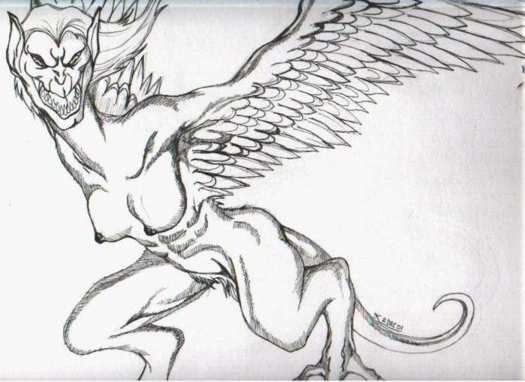 |
| The Cyclop The Cyclopes were one-eyed giant that were mentioned in Greek Myth, there were 2 generations of Cyclopes and the picture showed one of the first generation cyclop known as Steropes, which is aptly translated as Flasher ( no pun intended here ). Steropes is one of the 3 brothers; the others being Brontes ( thunderer ) and Arges ( brightener ) who descended as a result of the union between Gaia ( Earth ) and Uranus ( Sky ). The second generation of Cyclopes were those descended from Poseidon, the sea-god. The most noteable Cyclop being Polyphemus who was mentioned in the Odyssey by Homer. The first generation Cyclopes were skilled in the art of metallurgy, they were the inventive blacksmiths of the Olympian gods and were credited for creating Zeus ' thunderbolts, Poseidon's trident and Hades' Helmet of Darkness. In the great Battle of the Titans, Zeus enlisted the ally of these Cyclopes in overthrowing his adversary Cronus and the Titans. |
|
|
The Piasa Its by far the rarest of all beasts either in the web or any other reading materials, very few pictures found; hope that this illustration will breathe life to it here and more people noticing it. Several explorers in 1673 discovered on a limestone cliff, images of a creature which later came to be known as the Piasa. It is described to have beaming red eyes, human facial features, lion's mane, a dragon-like scaly body and the most distinctive of them all; a tail that's twice as long as its body. |
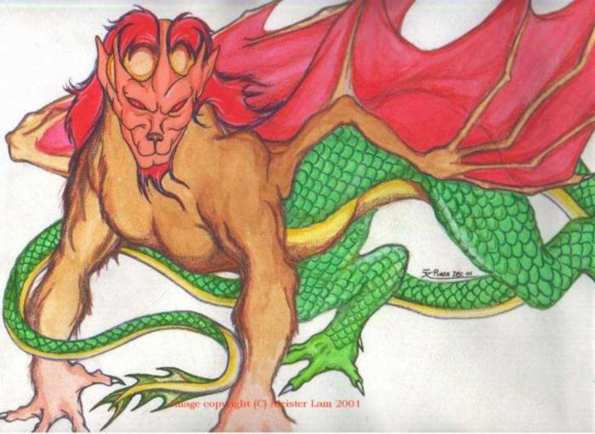 |
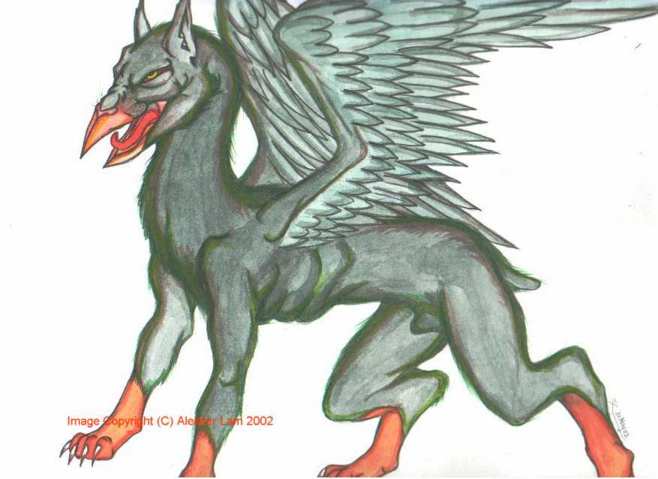 |
The Lupogryph It is really a sort of a challenge to be able to illustrate all the variations that the very popular mythical creature, the Gryphon have developed into and assimilated with other creatures to form its own unique breed in these modern times. Obviously the gryphon must have been a very promiscuous beast to have fathered so many different variations of offsprings. This picture is of a Lupogryph which is a gryphon with canine parts instead of the usual feline parts. If in heraldry the representation of the gryphon is that of strength and vigilance, then the lupogryph would be swiftness and surveillance; cause the combination would definitely enhance the existing senses making it more acute; therefore allowing the lupogryph to be the ultimate tracker or seeker of golds and gemstones amongst the Gryphon breeds. Stephen Scotus, an Irish writer of the 9th century wrote that gryphons are highly monogamous creature that once they have selected a life partner, they would mate for life; and that the gryphons will not find another mate if the other partner dies. Well, on the contrary, I believe gryphons are rather promiscuous and that the male gryphons definitely has more than one mate in their life-time, they are also very adventurous creatures that will mate with other animals like horses, foxes, dogs ( which result in the Lupogryph ) and even camels. Records from a St. Hildegard of Bingen, a German nun of the 12th century reveals the gryphon as egg-laying creatures similar to most avian animal, she also states that the expectant mother would nest her youngs in sheltered cavern with very narrow entrance. I disagree with her as I believe gryphons being endowed with wings and the ability to take flight would take advantage of it and built a nest on the peak of the highest mountain that it could reached away from potential danger from predators like lions, wild dogs and even Arimaspians. It would shield its hatchlings from the elements by raising its wings overhead like most birds do and stayed with it until the eggs hatched. |
|
Barnardin, The Fish-boy Mermaids are usually depicted as having scaly tails, however, many early descriptions of Merfolk mention their dolphin-like tails. Though scientists and skeptics have dismissed these sightings as most likely manatees, dugongs or Steller’s sea cows; the later became extinct by the 1760s due to over-hunting, yet there exist; though are very few, records that indicated that merman and fish-boy did walked amongst us.
In 1684, it was recorded that an Italian woman named Elizabeth Nastasia had gave birth to a fish boy in the city of Beiseiglia, Italy. According to the fish boy’s father Peter Anthony Consiglio, when the boy was born, his entire body was covered with shimmering scales similar to that of fish. Though his face was with no unseemly colour and his head was adorned with curious flaxen hair. He is of normal human stature with the sole of his feet being white and so are his palm, there is nothing unusual except for his scaly body. His parent name him Barnardin.
The mother, naturally being more protective of his only child was afraid for his safety and kept him hidden and prayed over him hoping for a change as he grew older. Unfortunately every time he would lose a scale another would be under it to replace it. Eventually when Barnardin was 10 years old, he was found to be quite intelligent and they sent him away to be privately educated. He could speak fluent Italian, French and Dutch but his education did not save him from being exploited. Whilst in London, Barnardin was recruited by a Mr. Barton who was a milliner by profession. He also lived next door to the coffee house at Charing Cross which were noted to be frequented by the royal families, hence he was exhibited as a mer-creature, the Fish boy as he was called, was not just a popular attraction in London to the royalty but also the commoners alike. |
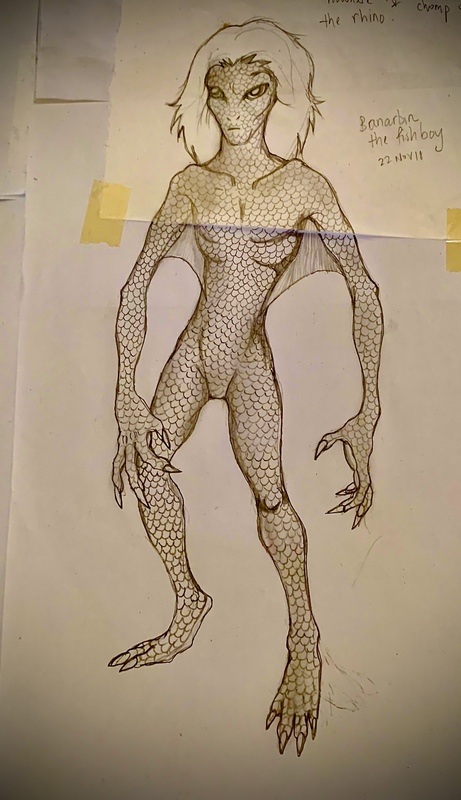 |
| The Rkishi It is more commonly known in folklore and mythology that a monstrous creature would disguised itself as beautiful woman to lure men to their lair and they notably would be a easy prey, rarely its the other way round. But there is an unique mythical entity that hails from the folklore of the Mbundu tribe of Angola, in Africa. It tells of a malevolent monstrosity that reveals to its victim; mainly young and beautiful women, its more handsome and captivating facial features of a young man. But hiding behind its straight, thick black shoulder-length hair is its more sinister true form - a snarling, salivating and malicious wolf-like face, some version also described it as having the face of a hyena. This monster is known as a Rkishi, it's described as having the frontal face of an attractive young man and at the rear side, a more bestial face similar to that of a wolf or hyena.
As this is a two-faced creature, with duo personality, it would uses its humanoid side to charm and deceive its victim, and upon gaining the trust would reveal its ugly side and devour its prey. Thus, in older Kimbundu language; native language of the Mbundu tribe, the Rkishi is associated with treachery and traitors. The Rkishi is a master of deceit and is absolutely unreliable in nature.
The modus operandi of the shape-shifter is to utilize its suave and good looks to entice and charm its victim, and lure her to a secluded place, likely its lair and then turn around and part its hairs, revealing the hidden wolf-like head. The concealed animalistic head would then protrude out and its body would then shape-shift into to its more menacing bestial form and using its canine snout and bone-crushing jaws; it would first go for the face of its victim and once it bite-on to its 'food', nothing would be able to pry open the powerful bite force of its jaws, until the skull is crushed and its prey is left lifeless and it would proceed to devour the rest of the body. Even if the Rkishi is careless enough to allow its victim to escape from its lair, the keen canine sense of smell would enable it to track its prey down easily, but it would taunt and terrorize its victim, relishing the moment and enjoy feeding off her fear before going in for the kill; thus its rare that a female victim of the Rkishi is able to live and tell her tales.
Aside from being a smooth talker, charming characteristics, excellent sense of smell; adding to its 'bag of trickeries', the Rkishi also possesses a magical bell which will only emit a chime when a female that the monstrosity is destined to mate with approaches. The pleasant chimes will assist it to attract the unsuspecting victim and would open up an opportunity for the Rkishi to seduce, copulate and impregnate the woman, allowing her to have its offspring. Upon giving birth to the vile two-faced baby creature, the mother will be swiftly killed and be devoured by both the father and newborn. The only sure way to dispose a Rkishi is to pierce a burning stake into its heart and this would temporarily stun it. The brave person would then need to dismember the monster and bury the various parts separately, this would be the only way ensuring and preventing the Rkishi from rising again. |
|